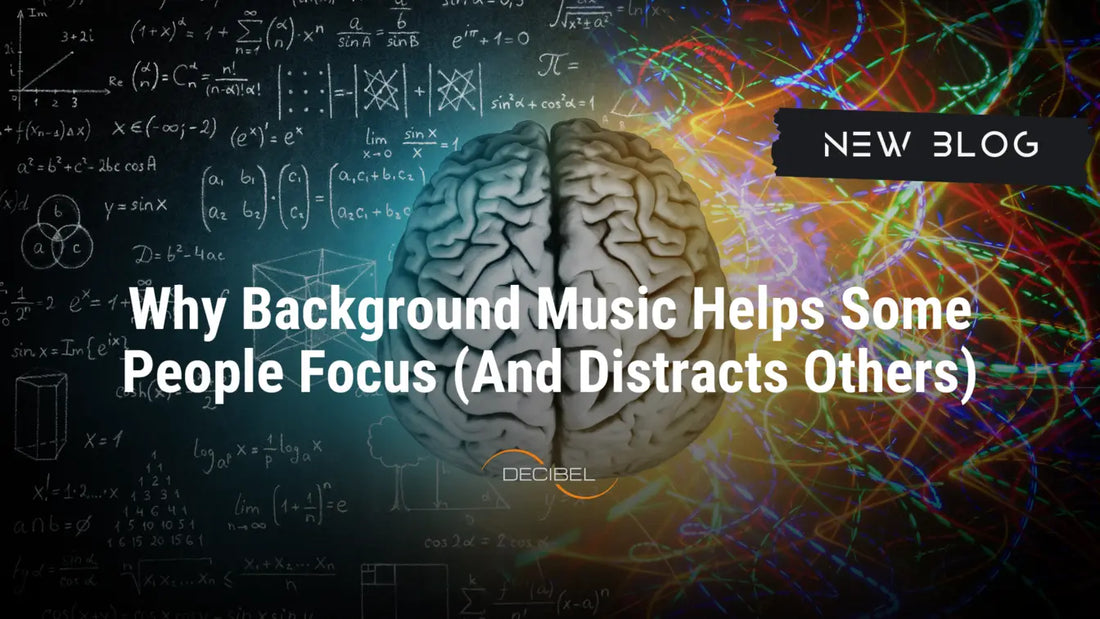
Why Background Music Helps Some People Focus (And Distracts Others)
Tanya IlievaShare
📖 Reading time: 7 min and 51 sec
Have you heard about the "elevator pitch"? The 30-second window to introduce yourself or your idea in a way that covers a key point or two, while making a connection with the one you're talking to?
Let's take this example literary. You enter in an elevator to get to the 17th floor of a business tower where you are about to meet a VIP you have been desperately trying to reach for a year. You're alone in the cabin. And here it is the smooth office jazz running in the background.
What will happen in your head? Does the background music help you focus on your presentation? Or does it mess up with your thoughts?
For some, a gentle melody hum is the perfect ambience for concentration and creativity; for others, it becomes a distraction that disrupts their focus. The contrasting effects of background music have puzzled many, and it turns out that individual differences in brain processing, personal preferences, and the type of tasks at hand all play a role.
So let's dive into the science behind music’s influence on focus, let's explore both its benefits and drawbacks and offer practical insights to help you optimise your sound environment for the best.
The Science Behind Music and Focus
Music is fundamentally composed of sound waves that are characterised by their frequency, which determines pitch, and their amplitude, which dictates loudness. These sound waves have profound effects as they interact with our auditory system and influence brain chemistry in various ways. The impact of a particular piece of music can vary greatly depending on the context in which it is experienced. Factors such as the music's rhythm, volume, and complexity can either enhance focus and productivity or serve as distractions.
Extensive research has demonstrated several key mechanisms through which music affects our psychological and physiological states:
Neurotransmitter Modulation
Engaging with music stimulates the release of dopamine, a neurotransmitter closely linked to feelings of pleasure, reinforcement, and motivation. This biochemical reaction can enhance concentration and focus, making it easier to engage in complex tasks or studies.
Brainwave Synchronisation
The rhythmic elements of music can align with the natural rhythms of our brainwaves, promoting different mental states. For instance, slower tempos, often found in calming music, can induce relaxation and reduce stress levels, while music with quicker beats can elevate alertness and energise the listener. This synchronisation can play a key role in tailoring mental states to the demands of specific activities (including eating, exercising in fitness or shopping...)
Selective Attention
Scientific studies, including those conducted by psychologist Glenn Schellenberg in 2005, have shown that background music can effectively mask distracting environmental noises. This masking effect allows the brain to concentrate more effectively on a primary task without the interference of sudden, distracting sounds. For example, in some offices, the background music serves as a white noise machine.
Benefits of Listening to Music While Studying and Working
When selected thoughtfully, background music can serve as an effective tool for enhancing both productivity and overall well-being:
Enhanced Concentration
Background music can mask distracting sounds from the environment, providing a steady auditory backdrop that helps individuals maintain focus. Research indicates that instrumental tracks, particularly those without lyrics, are especially beneficial for task performance. This is because they eliminate the automatic brain response to decipher speech when it is in a familiar language. Additionally, instrumental music reduces the brain's tendency to engage with sudden auditory interruptions, allowing for a smoother cognitive flow.
Stress Reduction
Soothing melodies have been shown to lower levels of cortisol, a hormone associated with stress, leading to a more relaxed mental state that promotes sustained concentration. In various therapeutic settings, ambient sounds, such as gentle rain or subtle ocean waves, are employed to alleviate anxiety and enhance mood, creating an atmosphere conducive to calmness and creativity. Remember the soundscape during your last full body massage and you will easily agree with this point.
Improved Memory and Learning
Evidence suggests that listening to background music can significantly benefit information retention, especially when the music is non-intrusive. Students who engage with soft instrumental music during their study sessions tend to demonstrate improved recall and understanding, suggesting that such melodies can enhance cognitive performance by creating a favourable learning environment. Sorry, heavy metal fans!
Increased Creativity
Certain soundscapes, such as nature sounds or light jazz, have been found to stimulate creative thinking by cultivating a relaxed yet alert mental state. This phenomenon is supported by academic research and resonates with insights from professionals across various fields, who highlight the value of a carefully curated audio experience in unlocking creative potential.

Disadvantages and When Music Can Distract
While many people appreciate the advantages of background music, its effectiveness can vary significantly from person to person. Here are some common challenges associated with it:
Overly Complex or Loud Music
Music that features complex melodies, extensive lyrics, or rapidly changing tempos can often divert attention from the task at hand. These elements can overload the brain's cognitive resources, making it more difficult to maintain focus on work or study tasks. Instead of enhancing productivity, such music can become a source of distraction that hinders performance. The same applies to excessive noise at your place.
Inconsistent Volume
Sudden fluctuations in volume can be particularly disruptive to concentration. When the sound level fluctuates unexpectedly, it can trigger the brain's alert system, causing individuals to become distracted and lose their train of thought. A consistent sound level is crucial for creating an environment that facilitates deep focus.
Individual Sensitivity
Everyone reacts differently to auditory stimuli. For individuals who have auditory sensitivities or conditions like ADHD, certain genres of music or soundscapes can exacerbate their challenges with concentration. For these individuals, music might transform from a potential aid into a significant hindrance, making it difficult for them to complete tasks effectively.
Task-Specific Distraction
The nature of the task at hand plays a crucial role in determining the impact of background music. Activities requiring deep analytical thinking, critical reasoning, or complex problem-solving often suffer from the presence of even mild background music. In these cases, the brain struggles to filter out competing stimuli, which can lead to decreased cognitive performance and increased frustration.

Tips to Tailor Your Sound Environment
Individual responses to music can vary significantly from person to person, highlighting the importance of customisation in musical experiences. Factors such as cultural background, personal experiences, and current emotional state all play a crucial role in how someone perceives and reacts to different genres, melodies, and rhythms.
Therefore, tailoring music to suit individual preferences and emotional needs can enhance engagement and enjoyment, making personalised playlists and curated soundscapes invaluable for maximising the impact of music on listeners. We've shortlisted several tips to help you start from somewhere:
-
Experiment with Genres: Many find that instrumental or classical music provides a calm background, whereas pop or rock with lyrics might be distracting.
-
Adjust Volume and Tempo: A low volume is generally less intrusive. Research suggests that slower tempos help induce a relaxed state, ideal for tasks requiring deep concentration.
-
Use White Noise or Ambient Sounds: For those who find music too engaging, white noise or nature sounds (like rainfall or ocean waves) can offer a neutral auditory backdrop that still masks distracting noises.
-
Test and Adapt: Experiment with different soundscapes during various tasks. Apps that allow customisable sound environments can be very helpful in this process.
These customisations ensure that your sound environment aligns with your personal and professional needs, enhancing productivity without causing distraction.

Acoustic Environments: Where Background Music Elevates the Experience
Background music isn’t one-size-fits-all—it has its best applications in specific settings:
-
Home Offices: A subtle, continuous instrumental track can mask household distractions and help maintain focus during work hours.
-
Elevators: Soft background music in elevators can ease stress and make short trips more pleasant.
-
Retail Stores: Music in retail spaces isn’t just for ambience—it can be tuned to influence shopping tempo. Studies show that a slower tempo encourages customers to linger, increasing the likelihood of a purchase.
-
Restaurants: In dining areas, carefully selected background music enhances the atmosphere, promoting a relaxed dining experience without overwhelming conversation.
-
Schools and Libraries: Ambient soundscapes or low-volume instrumental music can help create quiet zones that facilitate concentration and reduce disruptive noise.
Each of these environments benefits from the customised acoustic atmosphere that either enhances the experience or mitigates unwanted noise, underscoring the importance of a tailored approach.

How Rhythm and Tempo Influence the Brain
The rhythm and tempo of music hold a crucial influence over our brains, shaping our emotions and mental states in profound ways. Here is a summary of how these musical elements interact with our neural processes:
Brainwave Entrainment
Have you heard about the mirror neurons discovered by the Italian neurophysiologist Giacomo Rizzolatti?
The American Psychological Association explains it well: "Mirror neurons are a type of brain cell that respond equally when we perform an action and when we witness someone else perform the same action."
Something similar happens when we listen to music - it can harmonise with our brainwaves (they are mirroring each other). When listening to music with a steady, inviting rhythm, our brain can shift into a serene groove, promoting feelings of relaxation and alertness. The gentle pulsations of alpha brainwaves (ranging from 8 to 12 Hz) are often linked to a state of calm attentiveness.
Physiological Effects
The tempo of music can evoke striking physiological responses within us. Slow melodies can cradle our hearts, lowering our heartbeat and washing away the stresses of the day. In contrast, lively and rhythmic beats infuse us with vitality, boosting our concentration and energising our spirits.
ADHD and Focus
For individuals navigating the challenges of ADHD, the power of music can be especially transformative. Research has shown that a consistent rhythmic backdrop can serve as an anchor in a turbulent sea of distractions, allowing these individuals to sustain focus without being swept away by sudden changes. This rhythmic support acts as a gentle guide, helping them navigate their tasks with greater clarity and calm.
Finding Your Perfect Sound Environment
The way we experience sound is both a science and an art. Whether you’re trying to boost productivity in your home office, create a soothing atmosphere in a retail space, or simply enjoy a quiet evening at home, the right background music can make all the difference. The key is personalisation. Experiment with different genres, volumes, and tempos until you find your perfect auditory balance for each of the tasks you perform. As research continues to unveil the intricacies of sound and its effects on our minds, the power to shape our environment through acoustic design becomes ever more accessible and essential.
Meanwhile, if you are sure that you are one of those whose brain is negatively affected by the background music (even in the elevator) - there's always a solution: take the stairs! Thus, not only your brain will thank you but your heart too.
Additional Reading & Bibliographic Resources
-
Everest, F. A., & Pohlmann, K. C. (2015). Master Handbook of Acoustics (6th ed.). New York: McGraw-Hill Education.
-
World Health Organization. (2018). Environmental Noise Guidelines for the European Region. WHO Regional Office for Europe.
-
Basner, M., Babisch, W., Davis, A., Brink, M., Clark, C., Janssen, S., & Stansfeld, S. (2014). "Auditory and Non-Auditory Effects of Noise on Health." The Lancet, 383(9925), 1325-1332.
-
Schellenberg, E. G. (2005). "Music and Cognitive Abilities." Current Directions in Psychological Science, 14(6), 317-320.
-
Shih, Y. N., Huang, W. S., & Chiang, C. L. (2012). "Effects of Background Music on Attention in Children with ADHD." Journal of Attention Disorders, 16(8), 645-654.
-
Hallam, S., Price, J., & Katsarou, G. (2002). "The Effects of Background Music on Primary School Pupils' Task Performance." Educational Studies, 28(2), 111-122.




